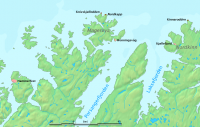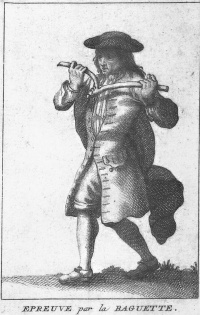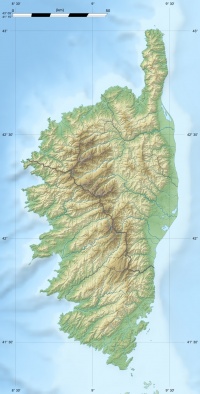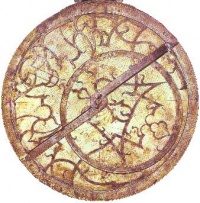Chapter 74: 717-732
Contents
Page 717
North CapeNorth Cape (Norwegian: Nordkapp) is a cape on the island of Magerøya in northern Norway, in the municipality of Nordkapp. Its 307 m high, steep cliff is often referred to as the northernmost point of Europe, located at 71°10′21″N 25°47′40″E / 71.1725°N 25.79444°E / 71.1725; 25.79444, 2102.3 km from the North Pole. However, the neighbouring point Knivskjellodden is actually 1,457 metres further north. Moreover, both of these points are situated on an island, which means the northernmost point of mainland Europe is in fact Cape Nordkinn (Kinnarodden), about 20 km from the village of Mehamn. From WIKI
Cherry Island
Cherry Island is the only island in Loch Ness, Highland, Scotland, and is an example of a crannog. The island is about 150 yards (140 m) from the shore near the southern end of the loch... A castle stood on the island during the 15th century; this was constructed of stone and oak wood and was probably used as a fortified refuge. It has been suggested that Cherry Island may have been a hunting lodge, with Dog Island the home for the hunting dogs. From WIKI
pro forma
The term pro forma (Latin "as a matter of form") is a term applied to practices that are perfunctory, or seek to satisfy the minimum requirements or to conform to a convention or doctrine. From WIKI
Page 718
Boswell
James Boswell, 9th Laird of Auchinleck (October 29, 1740 - May 19, 1795) was a lawyer, diarist, and author born in Edinburgh, Scotland; he is best known for his biography of Samuel Johnson. His name has passed into the English language as a term (Boswell, Boswellian, Boswellism) for a constant companion and observer. From WIKI
Nitre, for Gunpowder
Nitre is the mineral form of potassium nitrate, KNO3, also known as saltpeter (US) or saltpetre (UK). Historically, the term "nitre" – cognate with "natrium", a Latin word for sodium – has been very vaguely defined, and it has been applied to a variety of other minerals and chemical compounds, including sodium nitrate (also "soda nitre" or "cubic nitre"), sodium carbonate and potassium carbonate. From WIKI
Page 719
crepuscular
See page 465.
Scows
A scow, in the original sense, is a flat bottomed boat with a blunt bow, often used to haul garbage or similar bulk freight; cf. barge. The etymology of the word is from the Dutch schouwe, meaning such a boat. From WIKI
Ulster
Ulster is one of the four Provinces of Ireland, located in the north of the island. Ulster is composed of nine counties: Antrim, Armagh, Down, Fermanagh, Londonderry, and Tyrone are part of Northern Ireland; while Cavan, Donegal, and Monaghan are part of the Republic of Ireland. From WIKI - Also, see page 572.
Page 720
Fairy Lights
Decorative lights, most likely lots of small candles lit in a cluster, etc, similar to what we now know as Christmas lights.
hypnagogickally
See page 338.
"Sandwich"
See pages 366-367.
Donegal
Donegal is a town in County Donegal, in the Province of Ulster, in Ireland. Donegal is not the county town (capital) of County Donegal, despite being its namesake, however until the early 17th century it was the capital of the larger former Kingdom and Principality of Tyrconnell... Donegal town is situated at the mouth of Donegal Bay, on the River Eske and is overshadowed by the Bluestack Mountains. The Irish name translates into English as Fort of the Foreigners (Vikings). From WIKI
Munchausen
See page 350.
Page 721
'as above, so below'
See page 487.
fluxions
See page 602.
Reverend Dr. Taylor, an Infinite Series
In mathematics, the Taylor series is a representation of a function as an infinite sum of terms calculated from the values of its derivatives at a single point. It is named after the English mathematician Brook Taylor (see page 384). If the series is centered at zero, the series is also called a Maclaurin series, named after the Scottish mathematician Colin Maclaurin. It is common practice to use a finite number of terms of the series to approximate a function. The Taylor series may be regarded as the limit of the Taylor polynomials. From WIKI
Epsilonics... Defective Zero
See page 482.
Imp
An imp is a mythological being similar to a fairy or demon, frequently described in folklore and superstition. The word may perhaps derive from the term ympe, used to denote a young grafted tree. Imps are often described as mischievous more than seriously threatening, and as lesser beings rather than more important supernatural beings. The attendants of the devil are sometimes described as imps. They are usually described as lively and having small stature... Originating from Germanic folklore the imp was a small lesser demon. It should also be noted that unlike the Christian faith and stories, demons in Germanic legends were not necessarily always evil. Imps were often mischievous rather than evil or harmful and in some regions they were attendants of the gods. From WIKI - Also, cf. page 63.
Oakboys
The Oakboys was a largely non-sectarian agrarian secret society on Ireland. They are also called Greenboys or Hearts of Oak. It was regulatory, concerned with a moral issue as they perceived it. It sprang up in Ulster in mid-1763. Its targets were the County cess, the road-building activities of the Grand Juries which the cess financed, and the perennial grievance of tithes. From WIKI
Dublin Pale
Eventually, after the 16th and 17th centuries, and especially after the Anglican Reformation and the Plantation of Ulster, many of the "Old English" settlers were gradually assimilated into the Irish population, in large part due to their relative reluctance to give up Roman Catholicism (those who worshiped in the Church of Ireland were rewarded with a higher status). They kept their version of the English language, which had Cornish influences, for the most part. They were in fact joined by other English Roman Catholics fleeing persecution under Queen Elizabeth I and subsequent monarchs. By the Tudor period, however, the Irish culture and language had regained most of the territory initially lost to the colonists: even in the Pale ‘all the common folk … for the most part are of Irish birth, Irish habit and of Irish language’. From WIKI
Lord Pennycomequick
See this LINK
Bordeaux
Bordeaux is a port city on the Garonne River in southwest France. It is the capital of the Aquitaine region, as well as the prefecture of the Gironde department. Its inhabitants are called Bordelais. From WIKI
Second Charles
See page 335.
Wag
A witty person. From WIKI
Page 722
Robin Hood
Robin Hood is a hero in English folklore, a highly skilled archer and outlaw. In particular, he is known for "stealing from the rich and giving to the poor," assisted by a group of fellow outlaws known as his "Merry Men". Robin and many of his men wore Lincoln green clothes. From WIKI
Buff
Buff is a pale yellow-brown colour that got its name from the colour of buff leather. From WIKI
the Folly
In architecture, a folly is a building constructed strictly as a decoration, having none of the usual purposes of housing or sheltering associated with a conventional structure. In the 18th century English gardens and French landscape gardening often featured Roman temples, which symbolized classical virtues or ideals. Other 18th century garden follies represented Chinese temples, Egyptian pyramids, ruined abbeys, or Tatar tents, to represent different continents or historical eras. Sometimes they represented rustic villages, mills and cottages, to symbolize rural virtues. "Folly" is used in the sense of fun or light-heartedness, not in the sense of something ill-advised. From WIKI
Topiary is the art of creating sculptures in the medium of clipped trees, shrubs and sub-shrubs. The word derives from the Latin word for an ornamental landscape gardener, topiarius, creator of topia or "places", a Greek word that Romans applied also to fictive indoor landscapes executed in fresco. No doubt the use of a Greek word betokens the art's origins in the Hellenistic world that was influenced by Persia, for neither Classical Greece nor Republican Rome developed any sophisticated tradition of artful pleasure grounds. From WIKI
Obelisks
An obelisk is a tall, narrow, four-sided, tapering monument which ends in a pyramid-like shape at the top. Ancient obelisks were often monolithic. From WIKI
Mr. Halfpenny's Rural Architecture in the Chinese Taste
William Halfpenny, English 18th-century architectural designer; he described himself as "architect and carpenter". His books deal almost entirely with domestic architecture, and especially with country houses in the neo-Gothic and Chinoiserie fashions which were so greatly in vogue in the middle of the 18th century. His most important publications, from the point of view of their effect upon taste, were New Designs for Chinese Temples, in four parts (1750-52); Rural Architecture in the Gothic Taste (1752); Chinese and Gothic Architecture Properly Ornamented (1752); and Rural Architecture in the Chinese Taste (1750-1752). This last book is believed to have introduced the word "gazebo" to the English language. From WIKI
Great Buddha
See this LINK for examples in the East.
Peat Baths
A peat pulp bath is a bath prepared of peat pulp from wetlands. Balneotherapy in form of peat pulp baths is offered in many health resorts. From WIKI
Page 723
Bog-bursts
See this LINK
Berm
A berm is a level space, shelf, or raised barrier separating two areas. Berm is a loanword from Dutch. From WIKI
"Slanes"
(Anglo-Irish) A spade for cutting turf or peat, consisting of an iron flat-bladed head and a long wooden shaft. From WIKI
Mathesis
See page 194.
Page 724
American Station of the Cross
See page 525.
cogitating
1. (intransitive) to meditate, to ponder, to think deeply
2. (transitive) to consider, to devise
From WIKI
Uber Bernouillis Brachistochronsprobleme
Johann Bernoulli posed the problem of the brachystochrone to the readers of Acta Eruditorum in June, 1696. He published his solution in Acta Eruditorum the following year in May, 1697 and noted that the solution is the same curve as Huygen's tautochrone curve. After deriving the differential equation for the curve by the method given above he went on to show that it does yield a cycloid. But his proof is marred by the fact that Bernoulli uses a single constant instead of the three constants, vm, 2g and D, above. Five mathematicians responded with solutions: Isaac Newton, Jakob Bernoulli (Johann's brother), Gottfried Leibniz, Ehrenfried Walther von Tschirnhaus and Guillaume de l'Hôpital. Four of the solutions (excluding l'Hôpital's) were published in the same edition of the journal as Johann Bernoulli's. In his paper Jakob Bernoulli gave a proof of the condition for least time similar to that above before showing that its solution is a cycloid... A Brachistochrone curve, or curve of fastest descent, is the curve between two points that is covered in the least time by a body that starts at the first point with zero speed and is constrained to move along the curve to the second point, under the action of constant gravity and assuming no friction. From WIKI
the local Frieze
Middle English term for a coarse woollen, plain weave cloth with a nap on one side. The nap was raised by scrubbing it to raise curls of fibre, and was not shorn after being raised, leaving an uneven surface. Panni frisi, "Frisian cloths", appear in medieval inventories and other documents. Frieze was woven in the English Midlands and Wales, and in Ireland from the fourteenth century, and later in Holland as well. From WIKI
Neep-Lantern
In Scotland, folklore, including that of Halloween, revolves around the ancient Celtic belief in faeries (Sidhe, or Sith, in modern Gaelic). Children who ventured out carried a traditional lantern (samhnag) with a devil face carved into it to frighten away the evil spirits. Such Halloween lanterns were made from a turnip, or "Neep" in Lowland Scots, with a candle lit in the hollow inside. From WIKI
Keadew
Keadue is a village in County Roscommon, Ireland on the R285 regional road close to the borders of County Leitrim and County Sligo. The name is sometimes also spelled Keadew. From WIKI
Tath
The droppings of cattle, as well as the luxuriant grass sprouting therefrom.
wan
1. Pale, sickly-looking.
2. Dim, faint.
From WIKI
Well of Saint Brendan
See page 134.
Galway
Galway, one of the largest cities in Ireland, situated on the west coast of Ireland, has a complex history going back around 800 years. The city was the only medieval city in the province of Connacht. From WIKI
Page 725
Cavan
Cavan (meaning "The Hollow") is the county seat of County Cavan in Ireland. It is one of the three counties, the others being Monaghan and Donegal, which are part of the Irish province of Ulster but are part of the Republic. The town lies in the northeast of the island, along the border with Northern Ireland. The town is located on the main road - the N3 road - linking Dublin (to the south) with Enniskillen, Ballyshannon and Donegal Town (to the north). From WIKI
Dowsing, sometimes called divining, doodlebugging (in the US), or (when searching specifically for water) water finding or water witching, is a practice that attempts to locate hidden water wells, buried metals or ores, gemstones, or other objects as well as so-called "currents of earth radiation" without the use of scientific apparatus. A Y- or L-shaped twig or rod is sometimes used during dowsing, although some dowsers use other equipment or no equipment at all. From WIKI
Krees from his Dream in Cape Town
See page 70.
Traction
1. the act of pulling something along a surface using motive power
2. the condition of being so pulled
From WIKI
Holy Wells of Gloucestershire
A Holy Well is a spring or other body of water, revered either in a Pagan or Christian context, often both, as holy wells were frequently Christianized. The term 'Holy Well' is commonly employed to refer to any water source of limited size (i.e. not a lake or river, but including pools and natural springs and seeps), which has some significance in the folklore of the area where it is located, whether in the form of a particular name, an associated legend, the attribution of healing qualities to the water through the numinous presence of its guardian spirit or Christian saint, or a ceremony or ritual centred on the well site. In Christian legend, the water is often said to have been made to flow by the action of a saint, a familiar theme especially in the hagiography of Celtic saints. From WIKI - It is possible this is a reference to the Roman Villa in Chedworth, see LINK
Page 726
MiasmatickReeking, oppressing, having the nature of a miasma (a noxious atmosphere or emanation once thought to originate from swamps and waste to cause disease). From WIKI
Finger of Corsica
Corsica is the fourth largest island in the Mediterranean Sea (after Sicily, Sardinia, and Cyprus). It is located west of Italy, southeast of the French mainland, and north of the island of Sardinia. Corsica is one of the 26 régions of France, although strictly speaking Corsica is designated as a "territorial collectivity" (collectivité territoriale) by law. As a territorial collectivity, it enjoys greater powers than other French régions, but for the most part its status is quite similar. Corsica is referred to as a "région" in common speech, and is almost always listed among the other régions of France. Although the island is separated from the continental mainland by the Ligurian Sea and is much closer to the Italian than to the French mainland, politically Corsica is part of Metropolitan France. It was once briefly an independent Corsican Republic, until being incorporated into France in 1768. Corsica is famed as the birthplace of Napoléon Bonaparte. His ancestral home, Casa Buonaparte, is located there. From WIKI
page 727
Bradley
See page 173.
Péché Mortel
Mortal Sin
Mr. Chippendale
See page 336.
Clive... Clive of India
See page 74.
Venial
Pardonable; able to be forgiven. from WIKI
Page 728
Celadon
The term "celadon" for the pottery's pale jade-green glaze was coined by European connoisseurs of the wares. One theory is that the term first appeared in France in the 17th century and that it is named after the shepherd Celadon in Honoré d'Urfé's French pastoral romance, L'Astrée (1627), who wore pale green ribbons. (D'Urfe, in turn, borrowed his character from Ovid's Metamorphoses.) Another theory is that the term is a corruption of the name of Saladin (Salah ad-Din), the Ayyubid Sultan, who in 1171 sent forty pieces of the ceramic to Nur ad-Din, Sultan of Syria. Yet a third theory is that the word derives from the Sanskrit sila and dhara, which mean "stone" and "green" respectively. From WIKI
Revers
A lapel of a garment, turned back to show the reverse side. From WIKI
East Indiaman
An East Indiaman was a ship operating under charter or license to any of the East India Companies of the major European trading powers of the 17th through the 19th centuries. In Britain, the Honourable East India Company itself did not generally own merchant ships, but held a monopoly granted to it by Queen Elizabeth I of England for all English trade between the Cape of Good Hope and Cape Horn, which was progressively restricted during the late 18th and early 19th centuries. English (later British) East Indiamen usually ran between England, the Cape of Good Hope and India, often continuing on their voyages to China before returning to England via the Cape of Good Hope. Main ports visited in India were Mumbai (then Bombay), Chennai (then Madras) and Kolkata (then Calcutta). From WIKI
Harrison Watch
See page 201.
Hungarian Vampire
See page 425.
Board of Longitude... B. of L.
See page 141.
"Like watching Hamlet or something, isn't it?
Mr. Gonzago should know his Hamlet - 'The Murder of Gonzago' is the play-within-the-play.
Page 729
Bedlam
See page 351.
Veterans of Cartegena and Minorca
The Battle of Cartagena de Indias was the decisive battle of a massive amphibious expedition by the forces of Britain under Vice-Admiral Edward Vernon against Spain under Admiral Blas de Lezo, taking place at the city of Cartagena de Indias, in present day Colombia, starting in March 1741. It is the most significant battle in the War of Jenkins' Ear and one of the largest naval campaigns in British history, though it is now largely forgotten by the British. The war later blended into the greater conflict of the War of the Austrian Succession. The battle ended in a major defeat and heavy losses for the British: 50 ships lost and 18,000 casualties. From WIKI
The Battle of Minorca (20 May 1756) was a naval battle between French and British fleets, leading to the court-martial and execution of the British commander. It was the opening sea battle of the Seven Years' War in the European theatre. Shortly after Great Britain declared war on the House of Bourbon, their squadrons met off the Mediterranean island of Minorca. Although the fight was indecisive, and the French broke off battle first, the decision by the British to withdraw to Gibraltar handed France a strategic victory and led directly to the Fall of Minorca. The British failure to save Minorca led to the controversial court-martial and execution of the British commander, Admiral John Byng, for "failure to do his utmost" to relieve the siege of the British garrison on Minorca. From WIKI
Page 730
a Blank Sheet that invites Fiction and her vulgar Friends
This passage recalls the discussion that Wicks and his listeners had about "the Novel," earlier in the book; Cf. page 351.
Eleventh Commandment
The Eleventh Commandment is a term used to describe a rule or policy that is extremely important to the point of being sacred. From WIKI
Specifically, here, "I must not speak ill of another Clergyman" references a phrase utilized by Ronald Regan in his 1966 campaign for Governor of California: Thou shalt not speak ill of any fellow Republican WIKI
Schiehallion
Schiehallion is a prominent mountain in Perth and Kinross, Scotland. Schiehallion has a rich botanical life, interesting archaeology, and a unique place in scientific history for an 18th-century experiment in 'weighing the world'. From WIKI
Cavendish
Henry Cavendish FRS (10 October 1731 – 24 February 1810) was a British scientist noted for his discovery of hydrogen or what he called "inflammable air". He described the density of inflammable air, which formed water on combustion, in a 1766 paper "On Factitious Airs". Antoine Lavoisier later reproduced Cavendish's experiment and gave the element its name. Cavendish is also known for the Cavendish experiment, his measurement of the Earth's density, and early research into electricity. From WIKI
Mayer's Lunar Tables
Tobias Mayer (17 February 1723 – 20 February 1762) was a German astronomer famous for his studies of the Moon. From/See WIKI
Page 731
"-many wish'd for a faster way, willing to cede to Machinery a form of Human Effort they could've done without."
The human/machine hybrid recalls the title character of Herman Melville's short story 'Bartleby, the Scrivener: A Story of Wall Street.' The allusion seems even more pronounced in the exchange between Maskelyne and Mason on the following page where Mason says, "Maskelyne, - I cannot go...That is...if it pleases your Your Grace." Practically speaking, Mason's 'refusal' follows the same logic as Bartleby's famous rebuttal, "I prefer not to." Dehumanization of labor to increase efficiency and profit seems to be the mutual theme.
Investiture
Investiture, from the Latin (preposition in and verb vestire, 'dress' from vestis 'robe') is a rather general term for the formal installation of an incumbent (heir, elect of nominee) in public office, especially by taking possession of its insignia. The term is normally reserved for formal offices of state, aristocracy and church. From WIKI
Liripipes
A liripipe (also liripoop, liripipion, liripion) is a historical part of clothing, the tail of a hood or cloak, or a long-tailed hood, in particular a chaperon or gugel, or the peak of a shoe. In modern times, the liripipe mostly refers to an element of academic dress, the tail of the cowl of an academic hood. From WIKI
Tippets
A tippet is a stole or scarf-like narrow piece of clothing, worn around the arms and above the elbow. They evolved in the fourteenth century from long sleeves and typically had one end hanging down to the knees. In later fashion, a tippet is often any scarf-like wrap, usually made of fur, such as the 16th century zibellino or the fur-lined capelets worn in the mid-18th century. From WIKI
Passementerie
Passementerie or passementarie is the art of making elaborate trimmings or edgings (in French, passements) of applied braid, gold or silver cord, embroidery, colored silk, or beads for clothing or furnishings. From WIKI
See pages 365 & 628.
Astrolabe
An astrolabe (Greek: ἁστρολάβον astrolabon 'star-taker') is a historical astronomical instrument used by classical astronomers, navigators, and astrologers. Its many uses include locating and predicting the positions of the Sun, Moon, planets, and stars; determining local time (given local latitude) and vice-versa; surveying; and triangulation. From WIKI
Page 732
Honorarium
An honorarium is an ex gratia payment made to a person for their services in a volunteer capacity or for services for which fees are not traditionally required. This is used by groups such as schools or sporting clubs to pay coaches for their costs. Another example includes the payment to a guest speaker at a conference to cover their travel, accommodation, or preparation time. From WIKI




